With the gallery under construction and Smith Center in a state of flux, we find ourselves creatively improvising. Over the next six months we are replacing the yellow-construction tape with rotating mini exhibitions in our U Street window. We invited local installation artists for the second series of In-Flux to explore the concept of transformation and offer us a peek into their world.
Efflux, featuring John M. Adams. Jan. 13-Feb. 15, 2011
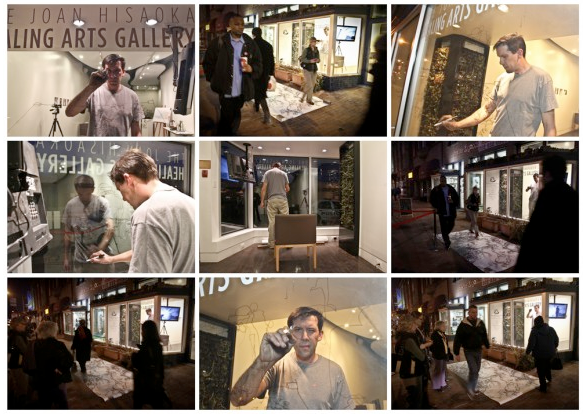 Adams’ work in Efflux straddles the domains of performance and installation art; consisting of a graphite drawing designed and created specific to the space, a video of Adams creating the drawing, and a final performance of the work’s on-site destruction. Together the components of Efflux offer a complete metaphor for evolution – moving the viewer through creation, existence and destruction. The feathery quality of Adams’ graphite line drawings evokes plumes of smoke, equally transitory and in keeping with the larger work’s momentary existence. Alongside the installation’s gestural work will also be a monitor looping footage of Adams creating the piece itself.
Adams’ work in Efflux straddles the domains of performance and installation art; consisting of a graphite drawing designed and created specific to the space, a video of Adams creating the drawing, and a final performance of the work’s on-site destruction. Together the components of Efflux offer a complete metaphor for evolution – moving the viewer through creation, existence and destruction. The feathery quality of Adams’ graphite line drawings evokes plumes of smoke, equally transitory and in keeping with the larger work’s momentary existence. Alongside the installation’s gestural work will also be a monitor looping footage of Adams creating the piece itself.
Fabricated Familiar, featuring Kristina Bilonick. Feb. 17-March 14, 2011
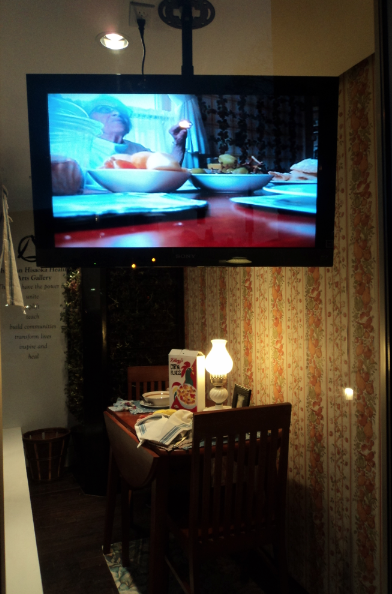
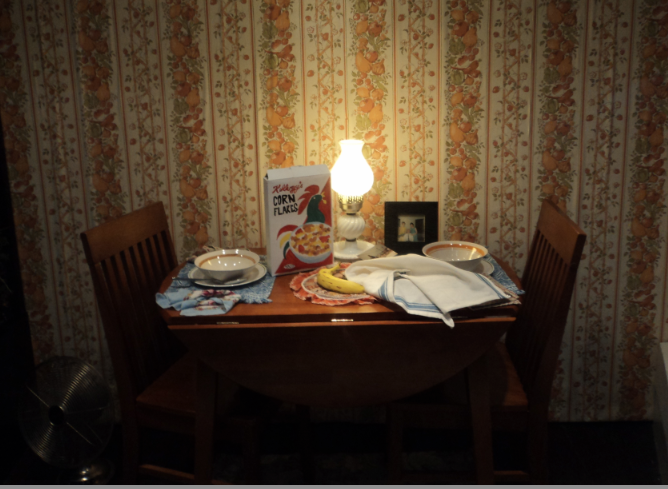 The work Kristina Bilonick creates explores ideas of personal history and memory. With fabricated familiar, Bilonick presents a space that everyone can relate to: a kitchen with a table, chairs, and food on the table. But this kitchen is actually a very specific place – it is the kitchen of her grandmother, Mary. From the wallpaper, to the rug, to the strewn items and the cookies on the plate, Bilonick recreates personal memory and a sense of the time spent visiting her grandmother. The artist writes: “My grandmother recently passed, and during the last years of her life she suffered from dementia. During these years she found comfort in surrounding herself with familiar things – certain foods, photos, books and papers. When she passed, I was not able to keep many of these items of hers, so I find solace in finding or creating objects similar to the ones she loved, and surrounding myself with them.”
The work Kristina Bilonick creates explores ideas of personal history and memory. With fabricated familiar, Bilonick presents a space that everyone can relate to: a kitchen with a table, chairs, and food on the table. But this kitchen is actually a very specific place – it is the kitchen of her grandmother, Mary. From the wallpaper, to the rug, to the strewn items and the cookies on the plate, Bilonick recreates personal memory and a sense of the time spent visiting her grandmother. The artist writes: “My grandmother recently passed, and during the last years of her life she suffered from dementia. During these years she found comfort in surrounding herself with familiar things – certain foods, photos, books and papers. When she passed, I was not able to keep many of these items of hers, so I find solace in finding or creating objects similar to the ones she loved, and surrounding myself with them.”
What Matters, featuring Judy Byron. March 31-May 25, 2011
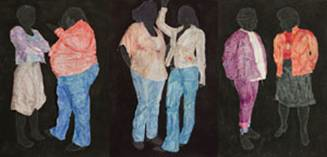 Byron uses the external cues of clothing, gesture, dialogue, and physical form to explore the elusive, identity of six, female subjects. In her work, What Matters, Byron paired three sets of woman in conversation, asked them to wear clothing they strongly identified with and prompted them to discuss “What Matters.” While these strangers sat in close dialogue Byron recorded their conversation and used photographs from their shared intimate moments to create life-size color pencil drawings of their bodies and clothing. Further adding to the work’s confluence of form and dialogue, the subjects were then asked to journal their inner thoughts on the reverse, hidden side of their drawings. Then the drawings were soaked in water and wrapped back upon their subjects, resulting in a cast form of each woman’s body and recalling the paper dolls of feminine childhood. While the sculptural drawings will be on display in 3 widows of the 1700 U Street NW block, pedestrians will also have the opportunity to call a phone line playing audio excerpts of the women’s conversations. By weaving the audio trace with the delicate, 3-D portraits, Byron pulls us deeper into her subjects’ private conversations and offers us a glimpse at the elusive nature of identity and self.
Byron uses the external cues of clothing, gesture, dialogue, and physical form to explore the elusive, identity of six, female subjects. In her work, What Matters, Byron paired three sets of woman in conversation, asked them to wear clothing they strongly identified with and prompted them to discuss “What Matters.” While these strangers sat in close dialogue Byron recorded their conversation and used photographs from their shared intimate moments to create life-size color pencil drawings of their bodies and clothing. Further adding to the work’s confluence of form and dialogue, the subjects were then asked to journal their inner thoughts on the reverse, hidden side of their drawings. Then the drawings were soaked in water and wrapped back upon their subjects, resulting in a cast form of each woman’s body and recalling the paper dolls of feminine childhood. While the sculptural drawings will be on display in 3 widows of the 1700 U Street NW block, pedestrians will also have the opportunity to call a phone line playing audio excerpts of the women’s conversations. By weaving the audio trace with the delicate, 3-D portraits, Byron pulls us deeper into her subjects’ private conversations and offers us a glimpse at the elusive nature of identity and self.
Material Narrative, featuring Victoria Greising. May 26-Aug. 15, 2011
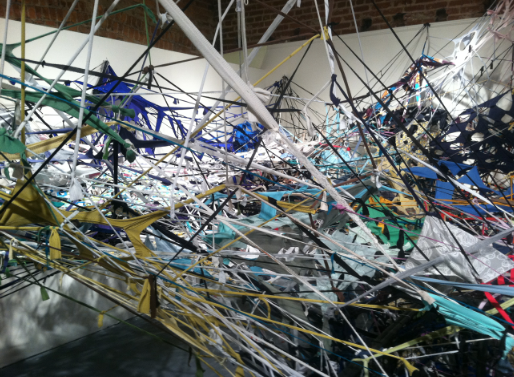 Clothing serves many purposes. The first and most obvious is the need to protect the body—comfort, warmth, etc. It is also a signifier of identity and personal history. Victoria Greising’s installations, in which she deconstructs and reconstructs clothing into environments and spaces, facilitate a new interaction and evoke an energetic sense of being surrounded, protected, and enveloped by clothing. Greising’s installations are an embodiment of the memories associated with the donated clothing, an activation of personal memories, and creation of new associations with material and space. In this 3-part, street-side installation, she intentionally uses garments that have a history— ranging from discarded, beat up t-shirts to shirts donated in memory of loved ones who have passed. Each article comes to her infused with a narrative, marks from its previous owner, and with unique material characteristics– holes, stains, dried out elastic. Yet, Greising is not illustrating individual narratives. She deconstructs and weaves these individual articles to create a new web of meaning. Mixing together, overlapping, and building on each other, Greising constructs a social network and physical representation of personal connections and memories.
Clothing serves many purposes. The first and most obvious is the need to protect the body—comfort, warmth, etc. It is also a signifier of identity and personal history. Victoria Greising’s installations, in which she deconstructs and reconstructs clothing into environments and spaces, facilitate a new interaction and evoke an energetic sense of being surrounded, protected, and enveloped by clothing. Greising’s installations are an embodiment of the memories associated with the donated clothing, an activation of personal memories, and creation of new associations with material and space. In this 3-part, street-side installation, she intentionally uses garments that have a history— ranging from discarded, beat up t-shirts to shirts donated in memory of loved ones who have passed. Each article comes to her infused with a narrative, marks from its previous owner, and with unique material characteristics– holes, stains, dried out elastic. Yet, Greising is not illustrating individual narratives. She deconstructs and weaves these individual articles to create a new web of meaning. Mixing together, overlapping, and building on each other, Greising constructs a social network and physical representation of personal connections and memories.


